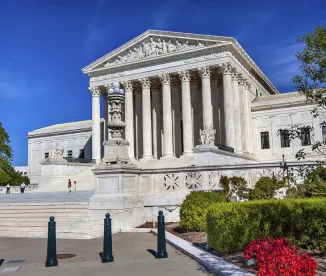Introduction
It is understandable that the press and legal commentators are focused on Judge Brett Kavanaugh’s jurisprudence and writings following his nomination to the Supreme Court. But we should not ignore how other justices’ views of precedent may affect the Court’s direction in the months and years after Justice Anthony Kennedy’s retirement. As Justice Byron White famously wrote, “[w]ith every new appointment, it’s a new court.”[1] In this time of transition, one justice under the microscope is Chief Justice John Roberts, who has occasionally joined the Court’s more liberal justices,[2] and who many think will assume Justice Kennedy’s role as the Court’s “swing” justice.[3] In light of this possibility, those hoping to predict the future of some of the Court’s more controversial precedents would do well to examine the Chief Justice’s view of stare decisis, the principle that legal issues should be determined based on precedent unless particularly compelling circumstances require otherwise.
During its most recent term, the Court twice[4] overruled longstanding precedent: In South Dakota v. Wayfair, Chief Justice Roberts dissented from the opinion of the Court overruling prior law, while in Janus v. AFSCME, he joined the majority to do just that.[5] Analyzing Chief Justice Roberts’s reasoning in these two cases may give clues about what the post-Kennedy Court might do if asked to reexamine its past decisions, particularly in controversial or closely decided cases.
South Dakota v. Wayfair
Facing tax revenue shortfalls, South Dakota’s legislature in 2016 enacted emergency legislation requiring out-of-state retailers to collect and remit sales tax on sales to South Dakota residents, regardless of whether the seller had a physical presence in the state. This made the legislation invalid under the Supreme Court’s decisions in National Bellas Hess v. Illinois, 386 U.S. 753 (1967), and Quill Corp. v. North Dakota, 504 U.S. 298 (1992), which held that, absent congressional authorization, states could not require remote sellers with no physical presence in the state to collect and remit taxes on sales to state residents.
In an opinion written by Justice Kennedy, the Court in Wayfair overruled Quill and Bellas Hess. The Court reasoned that, until Bellas Hess, the physical-presence rule had lacked any basis in precedent. Moreover, advances in technology and the growth of e-commerce had made it apparent that physical presence was an arbitrary, formalistic requirement: a remote seller might do far more business, and be far “closer” to a state’s residents, than even a brick-and-mortar store down the street.
Writing in dissent,[6] Chief Justice Roberts agreed that the physical-presence rule had been wrongly decided but argued that the Court should adhere to stare decisis and let Congress decide whether to abrogate Quill. Chief Justice Roberts also argued that e-commerce’s economic importance and the broad policy implications of changing the rules governing it made the issue more suitable for Congress rather than the judiciary to address. This was particularly so, Chief Justice Roberts said, since the Court already had the chance, when it decided in Quill, to overrule the physical-presence rule, but did not.
Janus v. AFSCME
In Janus, the Court considered whether Illinois violated the First Amendment’s prohibition on compelled speech by requiring public employees to pay “agency fees” to public-sector unions of which such employees were not members, but that served as their exclusive representative in collective bargaining. The Court had previously held in Abood v. Detroit Board of Education, 431 U.S. 209 (1977), that this was permissible as long as nonmembers were not charged for a union’s political activities. Mr. Janus argued that public union activities are inherently political and that even Abood-compliant agency fees violated his free-speech rights.
Chief Justice Roberts joined Justice Alito’s majority opinion overruling Abood. The Court held that charging agency fees to nonmember employees compelled them to subsidize speech they disagreed with, notwithstanding the government’s special role as an employer. The Court emphasized five factors that it said favored overruling Abood: (1) the quality of its reasoning, (2) the workability of the rule it established, (3) its consistency with related decisions, (4) developments since it was decided, and (5) reliance on the decision.[7] In applying these factors, the Court held that Abood’s reasoning incorrectly relied on cases involving private-sector unions—where free-speech considerations differed—and that identifying what union expenditures were nonchargeable political activities versus permissible agency fees was an imprecise if not impossible exercise. The Court also noted that some states had disallowed agency fees with no apparent harm to the collective bargaining process and that Abood’s deferential approach to state-compelled speech was an anomaly in First Amendment law. As for the unions’ asserted reliance on Abood, the Court reasoned that Abood’s lack of clarity, uncertainty surrounding its continued validity, the short-term nature of collective-bargaining agreements, and unions’ ability to better protect themselves by using different contract language all weakened the unions’ reliance interest.
Reconciling the Tension: “Could Congress Fix the Flaw If We Deferred to It?”
Chief Justice Roberts’s positions in these cases appear to be in tension: he voted to overrule precedent in Janus, but in Wayfair, he argued that an admittedly flawed precedent should nonetheless stand. Moreover, one reason he articulated in Wayfair for respecting precedent was that “in Quill . . . , this Court was invited to overrule Bellas Hess but declined to do so.”[8] Yet he joined an opinion in Janus that cited previous opportunities to overrule Abood—in which the Court had questioned Abood’s reasoning but left it intact—as putting “public sector unions . . . on notice for years regarding this Court’s misgivings about Abood.”[9]
While chalking up the discrepancy to ideology might be tempting, the nature of the constitutional question at issue might be the key to reconciling the apparent contradiction in Chief Justice Roberts’s position in these cases and to understanding his views about stare decisis in general. Janus involved the First Amendment, which limits government power to regulate freedom of speech, a right that the Court has the final say in defining. Wayfair, in contrast, involved the Commerce Clause, which grants Congress plenary power to regulate interstate commerce and, in its “dormant” manifestation, limits states’ ability to do so even if Congress is silent. This means that Congress could have overruled Quill but could not do anything about Abood.
Consistent with this distinction, the majority opinion in Janus explains as follows:
The doctrine [of stare decisis] is at its weakest when we interpret the Constitution because our interpretation can be altered only by constitutional amendment or by overruling our prior decisions. And stare decisis applies with perhaps least force of all to decisions that wrongly denied First Amendment rights . . . a fixed star in our constitutional constellation if there is one.[10]
Compare this to his dissent in Wayfair, where Chief Justice Roberts counseled maintaining the physical-presence rule:
Departing from . . . stare decisis is an exceptional action demanding special justification. The bar is even higher in fields in which Congress exercises primary authority and can, if it wishes, override this Court’s decisions with contrary legislation. In such cases, . . . the burden borne by the party advocating abandonment of an established precedent is greater than usual . . . [,] even where the error is a matter of serious concern, provided correction can be had by legislation.[11]
These passages suggest that harmonizing Chief Justice Roberts’s seemingly contradictory approaches in these two cases may depend on whether the issue under review is one on which Congress is able to have the final say. If so, Chief Justice Roberts may be more likely to favor adhering to precedent, even if he disagrees with it, or at least giving Congress a chance to address an issue before the Court does so.[12]
This conclusion must be qualified: Wayfair and Janus are only two decisions, making generalizations hazardous. Moreover, Chief Justice Roberts is said to be mindful of and concerned about his legacy, the proper role of the Court, and combatting the perception that the Court is a partisan actor.[13] And, as one commentator points out, the Court under Roberts has overturned fewer precedents than under other chief justices.[14] This scholar, however, also acknowledges that focusing on express reversals of precedent fails to account for the Court’s ability to significantly depart from or weaken prior decisions without overruling them.[15] Janus and Wayfair also come at an especially significant time, with Justice Roberts poised to become the Court’s decisional fulcrum. This shift might prompt litigants to ask the Court to re-examine or redefine the scope of its prior decisions on issues such as campaign finance, religious freedom, healthcare, executive power, abortion, privacy rights, and immigration.
Chief Justice Roberts’s votes in Wayfair and Janus suggest that the extent to which Congress has the power to fix a precedent he disagrees with is a key factor for him in deciding how much to defer to the Court’s prior decisions.
Notes
[1] Barry Bergman, Breyer: Faith in Reason, or Faith in Force?, BERKLEYAN (Apr. 16, 2009), https://www.berkeley.edu/news/berkeleyan/2009/04/16_breyer.shtml.
[2] See, e.g., Nat’l Fed. of Indep’t Businesses v. Sebelius, 567 U.S. 519 (2012).
[3] Oliver Roeder & Amelia Thomson-DeVeaux, How Brett Kavanaugh Would Change the Supreme Court, FIVETHIRTYEIGHT (Jul. 9, 2018), https://fivethirtyeight.com/features/how-brett-kavanaugh-would-change-the-supreme-court/ (explaining that, according to one empirical measure of judicial ideology, Brett Kavanaugh’s appointment would lead to Chief Justice Roberts replacing Justice Kennedy as the ideological “median” point).
[4] In addition to overruling precedent in Janus and Wayfair, the Court officially disavowed its infamous decision in Korematsu v. United States, 323 U.S. 214 (1944) (holding that forced relocation of U.S. Citizens of Japanese ancestry satisfied strict scrutiny), which was almost universally regarded as bad law but had never been expressly overturned. See Trump v. Hawaii, No. 17-965, slip op. at 38 (U.S. June 26, 2018) (“The dissent’s reference to Korematsu . . . affords this Court the opportunity to make express what is already obvious: Korematsu was gravely wrong the day it was decided, has been overruled in the court of history, and—to be clear—has no place in law under the Constitution.” (citation omitted)). We do not include the uncontroversial overruling of Korematsu in our discussion of Chief Justice Roberts’s approach to stare decisis.
[5] Janus v. Am. Fed’n of State, Cty. & Mun. Emps., No. 16-1466, slip op. at 47 (U.S. June 27, 2018) (“Janus v. AFSCME”), https://www.supremecourt.gov/opinions/17pdf/16-1466_2b3j.pdf; South Dakota v. Wayfair, Inc., No. 17-494, slip op. at 13 (U.S. June 21, 2018) (“Wayfair”), https://www.supremecourt.gov/opinions/17pdf/17-494_j4el.pdf.
[6] Justices Breyer, Sotomayor, and Kagan joined Chief Justice Roberts’s dissent.
[7] Janus, slip op. at 34–35.
[8] Wayfair, slip op. (post) at 1.
[9] Janus, slip op. at 45 (citing Friedrichs v. Cal. Teachers Ass’n, 578 U.S. ___ (2016) (per curiam); Harris v. Quinn, 573 U.S. ___ (2014)).
[10] Janus, slip op. at 34 (emphasis added) (citations omitted).
[11] Wayfair, slip op. (post) at 2 (citations omitted) (emphasis added).
[12] See Richard M. Re, The Doctrine of One Last Chance, 17 GREEN BAG 2d 173 (Apr. 7, 2014), http://www.greenbag.org/v17n2/v17n2_articles_re.pdf (observing that, before declaring major federal legislation constitutionally invalid, the Roberts Court “has tended to give the political branches one last chance to comply with the Constitution,” by avoiding the issue when a question of constitutionality is first presented, and then, if it arises a second time with no intervening congressional action, resolving the constitutional question).
[13] Jeffrey Rosen, Roberts’s Rules, THE ATLANTIC (Jan.–Feb. 2007), https://www.theatlantic.com/magazine/archive/2007/01/robertss-rules/305559/ (recounting the author’s interview with John Roberts in which the Chief Justice expressed his goal of being a consensus-driver and promoting unanimous decisions of the Court).
[14] Jonathan H. Adler, The Stare Decisis Court?, THE VOLOKH CONSPIRACY (July 8, 2018), https://reason.com/volokh/2018/07/08/the-stare-decisis-court (examining empirical data and positing that the Roberts Court has generally been reluctant to overturn precedent).
[15] Id.





 />i
/>i
